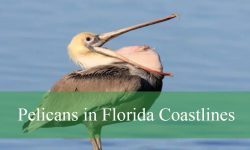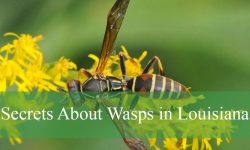Dragonflies are some of Ohio’s most colorful and fascinating insects, often seen skimming over ponds, lakes, and wetlands. Their vivid colors, patterns, and agile flight make them a favorite for nature watchers and photographers alike.
This guide highlights 30 common dragonflies and damselflies in Ohio, providing details on identification, habitats, and behaviors to help you recognize these incredible insects wherever you explore.
Types of Dragonflies Found in Ohio
Blue Dasher (Pachydiplax longipennis)
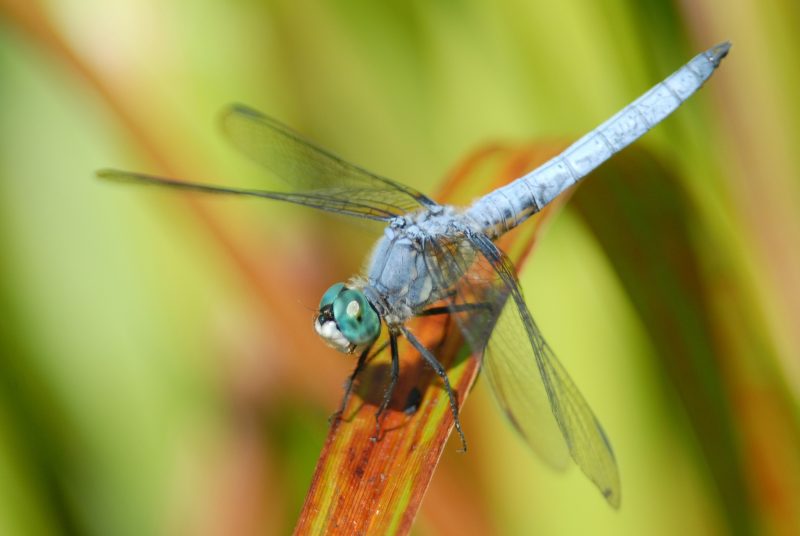
Blue Dashers are medium-sized dragonflies, approximately 1.5 to 2 inches in length, with a wingspan of 2.5 inches. Males display a vivid powder blue abdomen with a black thorax and yellow-striped legs, while females are more subdued with greenish-brown coloration. Both sexes have translucent wings with dark tips, giving them a distinctive appearance when in flight.
Behaviorally, Blue Dashers are fast and agile hunters, often darting low over ponds and marshy areas to catch small insects. They are territorial, with males frequently chasing rivals away from their chosen perching spots. Perching on vegetation near water, they maintain a constant lookout for both prey and potential mates.
In Ohio, Blue Dashers are commonly found near still or slow-moving waters, such as ponds, marshes, and wetlands. They thrive in areas with abundant emergent vegetation, which provides ideal perching and hunting opportunities. Observing them in early summer is common, as this is their peak activity period.
Common Green Darner (Anax junius)

The Common Green Darner is one of the most recognizable dragonflies in Ohio, notable for its large size and vibrant coloration. Adults typically measure about 3 inches in length, with a wingspan reaching up to 4 inches. Their thorax is bright green, while the abdomen is a striking blue in males and more subdued in females, making them easy to identify even from a distance.
This species is known for its powerful, continuous flight, often patrolling large areas near ponds, lakes, and marshes. Green Darners are aggressive hunters, preying on smaller insects like mosquitoes and flies. They are migratory in nature, sometimes traveling long distances across states, which makes sightings in different Ohio regions more frequent during summer and fall.
In Ohio, Common Green Darners are commonly found near freshwater habitats with abundant vegetation, including cattails and reeds. They play a critical role in controlling insect populations and are often seen perched on plants or patrolling open water. Their presence indicates a healthy aquatic ecosystem.
Eastern Pondhawk (Erythemis simplicicollis)
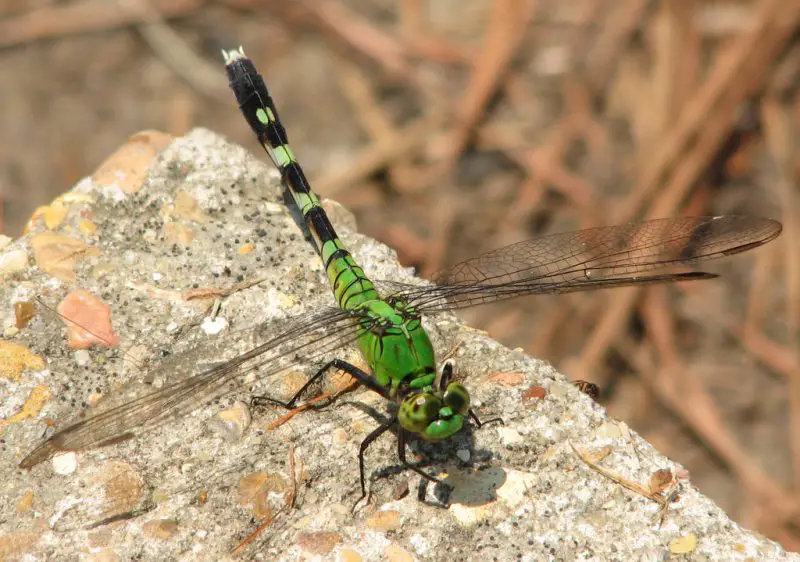
The Eastern Pondhawk is a medium-sized dragonfly, with adults measuring around 1.5 inches in length. Males exhibit striking powder blue abdomens and bright green thoraxes, while females and immature males are predominantly green, which allows them to blend into aquatic vegetation effectively. Their clear wings often feature dark tips, enhancing their visual appeal during flight.
These dragonflies are active hunters, known for their aggressive predatory behavior. Eastern Pondhawks feed on mosquitoes, flies, and even smaller dragonflies, making them formidable predators in their environment. Males are territorial and will defend their breeding sites vigorously against intruders.
In Ohio, Eastern Pondhawks are commonly spotted around ponds, lakes, and marshes with plenty of emergent plants. They prefer sunny areas where they can hunt effectively and are often seen perched low on stems, ready to launch into swift aerial pursuits. Their presence is an indicator of healthy freshwater ecosystems.
Halloween Pennant (Celithemis eponina)
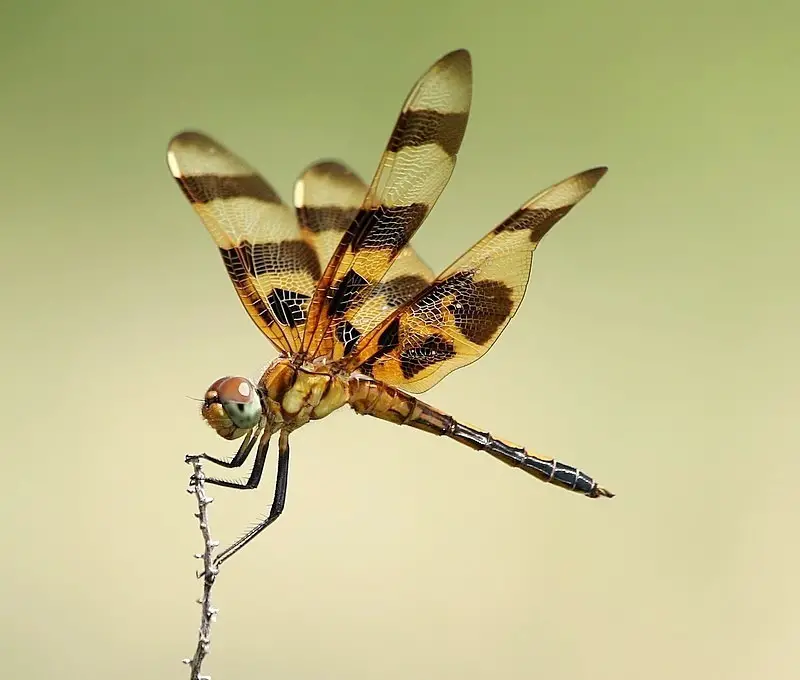
Halloween Pennants are small, delicate dragonflies measuring about 1.5 inches in length with a wingspan of roughly 2 inches. Their most striking feature is their vividly patterned wings, which are orange with distinctive brown bands and tips, reminiscent of Halloween colors. The slender, orange-brown bodies complement the patterned wings, creating a dramatic appearance in flight.
Behaviorally, Halloween Pennants are graceful fliers, often hovering or fluttering above ponds and marshes. They are skilled hunters, capturing small flying insects mid-air. Males often patrol small territories, performing elaborate flight displays to attract females and ward off rivals.
In Ohio, these dragonflies favor open, sunny wetlands with abundant emergent vegetation. They are typically found perched on tall grasses or reeds, gently swaying with the breeze. Halloween Pennants are more commonly observed from late summer into early fall, aligning with their peak activity and breeding season.
Widow Skimmer (Libellula luctuosa)
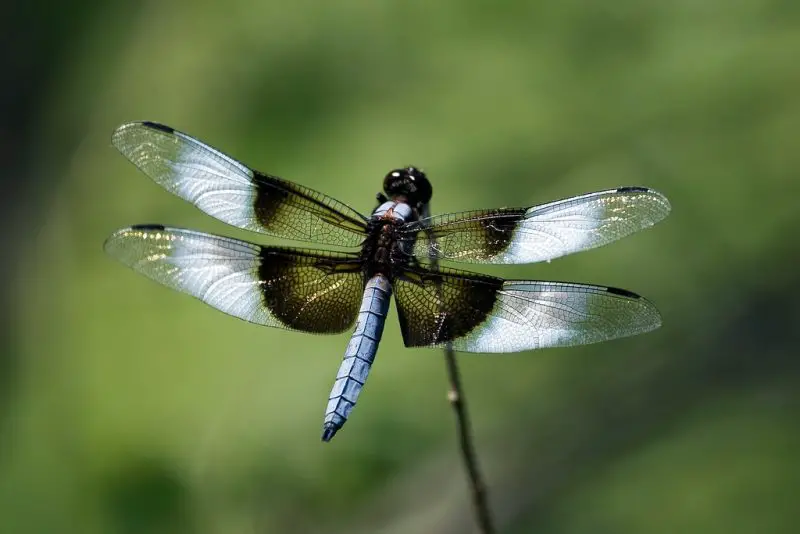
Widow Skimmers are medium-sized dragonflies, measuring approximately 1.5 to 2 inches in length with a wingspan around 3 inches. Adults have striking black and white banded wings, with males displaying broad white patches near the base of each wing, while females have more translucent wings with subtle markings. Their bodies are dark brown to black, adding contrast to the distinctive wing pattern.
These dragonflies are strong and direct fliers, often seen patrolling open water surfaces or perching prominently on sticks and reeds. They are highly territorial and will chase away other dragonflies to protect feeding and mating areas. Feeding primarily on mosquitoes and other small flying insects, Widow Skimmers are important predators in wetland ecosystems.
In Ohio, Widow Skimmers are frequently found near ponds, lakes, and slow streams with ample open sunlit areas. They prefer calm waters with surrounding vegetation for perching and hunting. Observing them on warm, sunny days is common, as they rely on sunlight for optimal flight and hunting activity.
Eastern Amberwing (Perithemis tenera)
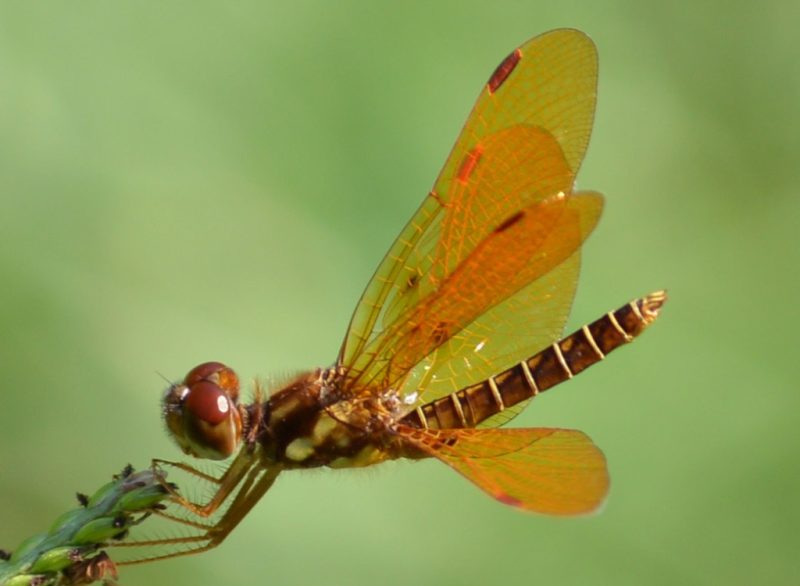
The Eastern Amberwing is a small dragonfly, typically measuring around 1 inch in length with a wingspan of about 1.5 inches. Its body is bright amber-orange, while the wings are mostly clear with golden-orange shading near the base, giving the species a warm, luminous appearance. Males often have more intense coloration than females, making them particularly striking in sunlight.
Behaviorally, Eastern Amberwings are fast and agile fliers, often patrolling small ponds, marshes, and slow streams. They feed on tiny insects such as gnats and midges, catching them mid-flight with quick darting movements. Males are highly territorial and frequently engage in aerial displays to defend their breeding areas from rivals.
In Ohio, Eastern Amberwings favor sunny, still water bodies with dense aquatic vegetation. They are often seen perched low on reeds or floating leaves, ready to launch into short bursts of hunting flight. Their small size and bright coloration make them easy to spot during the summer months.
Chalk-fronted Corporal (Ladona julia)
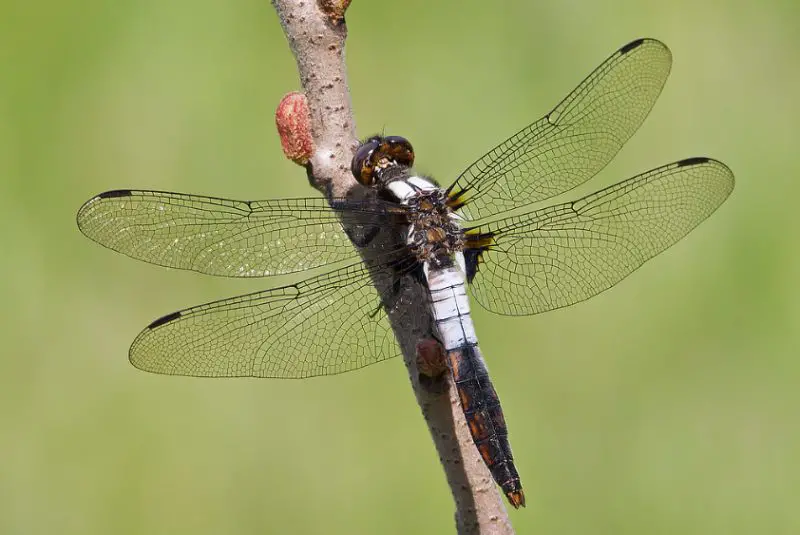
The Chalk-fronted Corporal is a medium-sized dragonfly, reaching about 1.5 inches in length with a wingspan near 2.5 inches. Its most distinctive feature is the pale, chalky-white coloration on the front of the thorax, contrasting sharply with a dark brown or black body. The wings are clear and unmarked, emphasizing the striking thoracic pattern.
These dragonflies are aggressive hunters, often perching prominently on sticks or reeds near ponds and streams to ambush passing insects. Males are highly territorial and will chase away other dragonflies to protect their hunting and breeding zones. They are known for quick, direct flights interspersed with short perching periods.
In Ohio, Chalk-fronted Corporals are commonly found around calm waters with emergent vegetation and open sunlight. They favor smaller ponds and slow streams where insect prey is abundant. Observations are most frequent in late spring and early summer, when adults are actively defending territories.
Four-spotted Skimmer (Libellula quadrimaculata)
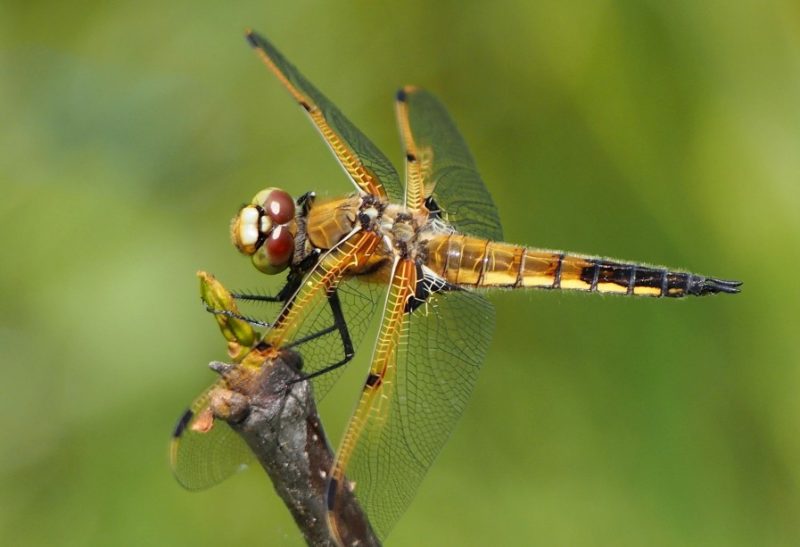
The Four-spotted Skimmer is a medium-sized dragonfly measuring around 1.5 to 2 inches in length, with a wingspan of approximately 3 inches. Adults have a dark brown to black body, and their clear wings are marked with four distinctive dark spots—one at each wing intersection—making them easy to identify. Males and females are similar in appearance, though males tend to have slightly brighter body coloration.
These dragonflies are strong fliers, often patrolling open ponds, lakes, and marshes. They are aggressive predators, feeding on mosquitoes, flies, and other small insects. Males are territorial, frequently chasing intruders and performing aerial displays to assert dominance over their breeding area.
In Ohio, Four-spotted Skimmers are typically found near freshwater habitats with plenty of sunlight and open water surfaces. They prefer calm ponds and marshes surrounded by grasses or low vegetation, which provide ideal perches and hunting grounds. Sightings are common from late spring through early fall.
Twelve-spotted Skimmer (Libellula pulchella)
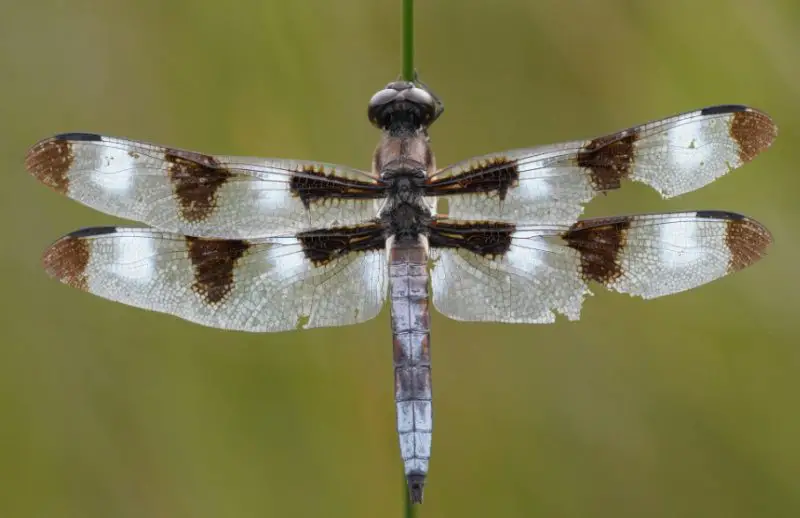
The Twelve-spotted Skimmer is a medium to large dragonfly, measuring about 2 inches in length with a wingspan around 3 inches. Its body is dark brown with a metallic sheen, and the wings are adorned with alternating black and white spots—three on each wing—resulting in twelve spots overall. Males typically have more pronounced white wing patches, while females’ patterns are subtler.
These dragonflies are agile and direct fliers, often patrolling open water edges and wetlands in search of flying insects. They are highly territorial, with males vigorously defending perches and hunting areas. Twelve-spotted Skimmers are often seen basking in the sun with wings spread, enhancing the visibility of their striking wing pattern.
In Ohio, Twelve-spotted Skimmers inhabit ponds, lakes, and slow-moving streams with abundant open water and emergent vegetation. They prefer sunny, calm areas where insect prey is plentiful and are most active during mid to late summer. Their presence is a common and unmistakable sight in Ohio wetlands.
Variegated Meadowhawk (Sympetrum corruptum)
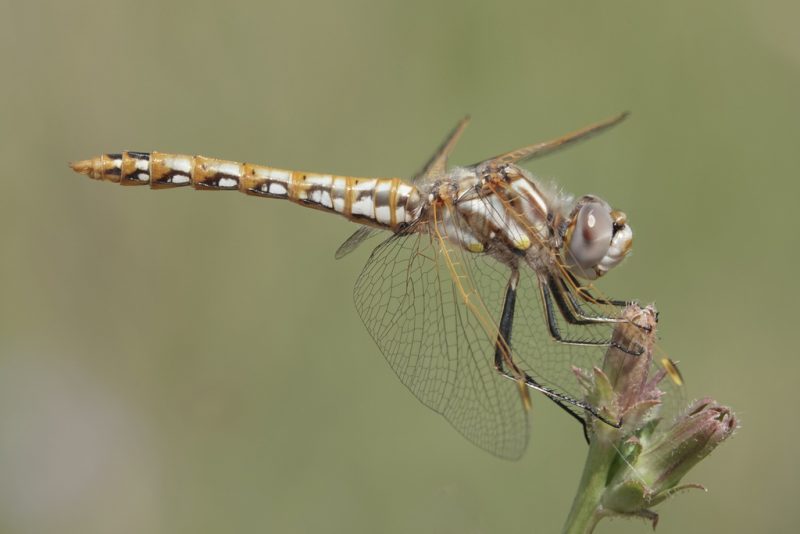
The Variegated Meadowhawk is a small to medium-sized dragonfly, typically 1.25 to 1.5 inches long, with a wingspan of about 2 inches. Males exhibit bright red abdomens with subtle black markings, while females are yellow to orange with brown accents. The wings are clear with reddish veins near the base, complementing the vivid body colors.
Behaviorally, Variegated Meadowhawks are active hunters, darting close to water surfaces to catch small flying insects. They are often seen perching on grasses or low vegetation at the edges of ponds, marshes, and slow streams. Males are territorial and perform aerial displays to secure prime breeding spots.
In Ohio, Variegated Meadowhawks are commonly found in sunny wetlands, ponds, and marshes with abundant emergent plants. They are particularly active in late summer and early fall, often forming swarms near water to feed and mate. Their bright colors and dynamic flight make them noticeable even in dense vegetation.
Autumn Meadowhawk (Sympetrum vicinum)
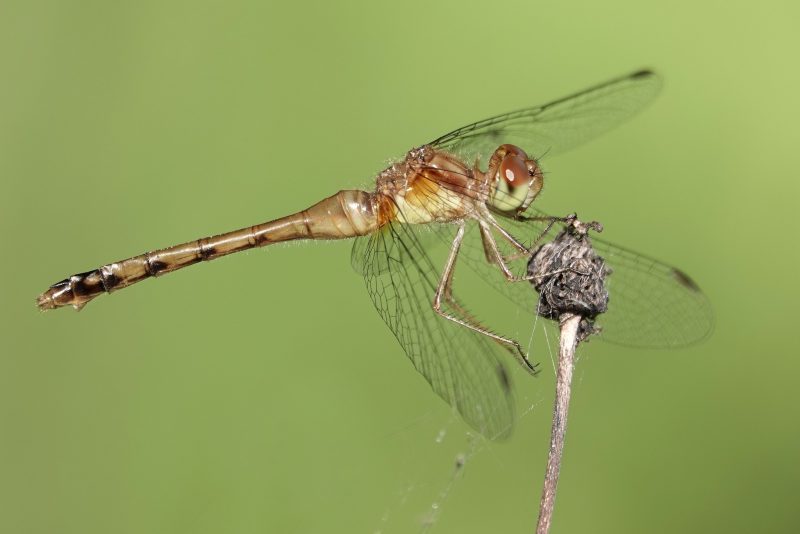
The Autumn Meadowhawk is a small dragonfly, usually measuring about 1.25 inches in length with a wingspan of roughly 2 inches. Males display bright red abdomens with black markings, while females and immature individuals are yellow to orange, helping them blend into their surroundings. Their wings are clear with faint reddish veins near the base, adding subtle contrast to their body colors.
These dragonflies are active and agile hunters, often patrolling open water and nearby vegetation to capture small insects such as midges and gnats. Males are territorial and will defend prime perching spots along pond edges and marshes. They are often observed hovering or performing short flights close to vegetation.
In Ohio, Autumn Meadowhawks are commonly found near ponds, lakes, and wetlands, especially during late summer and fall. They favor sunny, open areas with abundant emergent plants, which provide ideal hunting perches. Their vivid colors make them a noticeable presence in Ohio’s late-season dragonfly populations.
Slaty Skimmer (Libellula incesta)
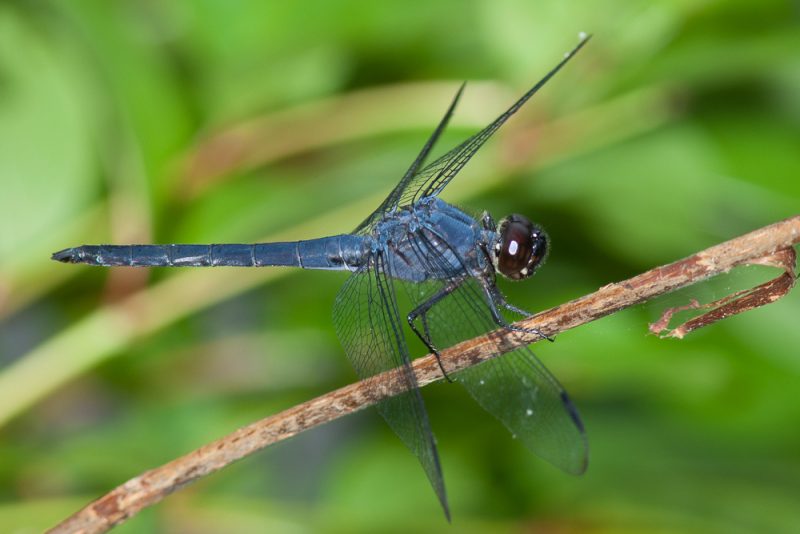
The Slaty Skimmer is a medium-sized dragonfly, measuring approximately 1.5 to 2 inches in length with a wingspan around 3 inches. Males are slate blue with dark brown to black thoraxes and white spots at the bases of the wings, while females are brown with yellowish markings. Both sexes have clear wings, making the colored body stand out prominently in flight.
These dragonflies are fast, direct fliers and aggressive predators, feeding on flies, mosquitoes, and other small insects. Males are territorial and often patrol open water areas, chasing rivals and performing aerial displays to defend feeding and breeding sites. They are frequently seen perching on low vegetation near ponds and marsh edges.
In Ohio, Slaty Skimmers inhabit calm ponds, lakes, and wetlands with open sunlit areas. They prefer habitats with plenty of emergent plants for perching and hunting. Sightings are most common in mid to late summer when adults are actively patrolling their territories.
Eastern Snaketail (Ophiogomphus severus)
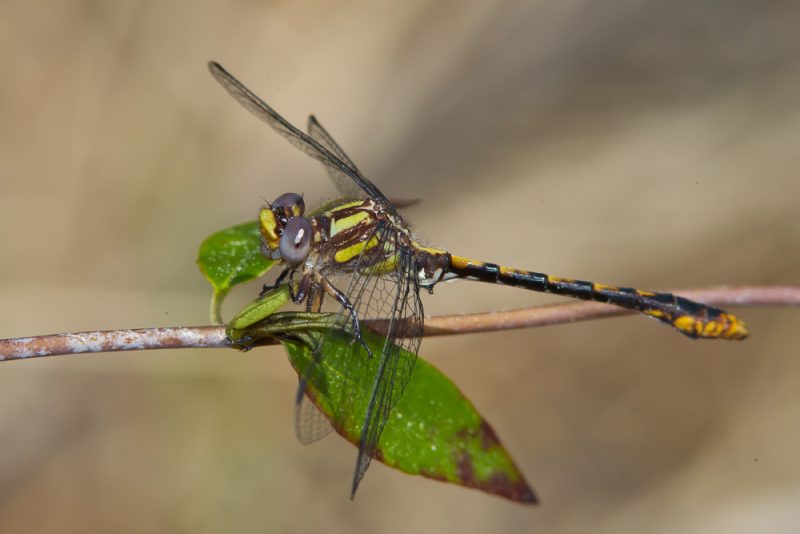
The Eastern Snaketail is a medium-sized dragonfly, typically 2 to 2.5 inches long with a wingspan of approximately 3 inches. It has a slender, elongated body that is dark green with yellow markings, giving it a striking appearance. The eyes are widely spaced, and the clear wings have a slight amber tint at the base, which helps with identification.
These dragonflies are agile fliers, often hunting along fast-flowing streams and rivers where they feed on small flying insects. Males are territorial and patrol their stretches of water vigorously. They are often observed perching on rocks, logs, or vegetation near the water, waiting to dart out for prey.
In Ohio, Eastern Snaketails prefer clean, well-oxygenated rivers and streams with moderate to fast flow. They are most commonly seen along riparian zones with ample sunlight and sparse vegetation, which allows them to hunt efficiently. Their presence is often an indicator of high-quality freshwater habitats.
River Cruiser (Macromia taeniolata)

The River Cruiser is a large, sleek dragonfly, measuring 2 to 2.5 inches in length with a wingspan of about 3.5 inches. It has a metallic green thorax and a long, slender black abdomen with yellow stripes. The wings are clear and long, adapted for fast, straight-line flights over water surfaces.
These dragonflies are strong, continuous fliers, often seen patrolling rivers and streams. They feed on smaller flying insects and are capable of covering long distances without stopping. Males establish territories along river stretches and engage in aerial displays to ward off competitors.
In Ohio, River Cruisers are typically found along medium to large rivers with open sunlight and minimal shading from trees. They prefer calm edges or slow pools along riverbanks for perching and hunting. Sightings are most common in mid to late summer when adults are actively cruising their aquatic habitats.
Common Sanddragon (Progomphus obscurus)
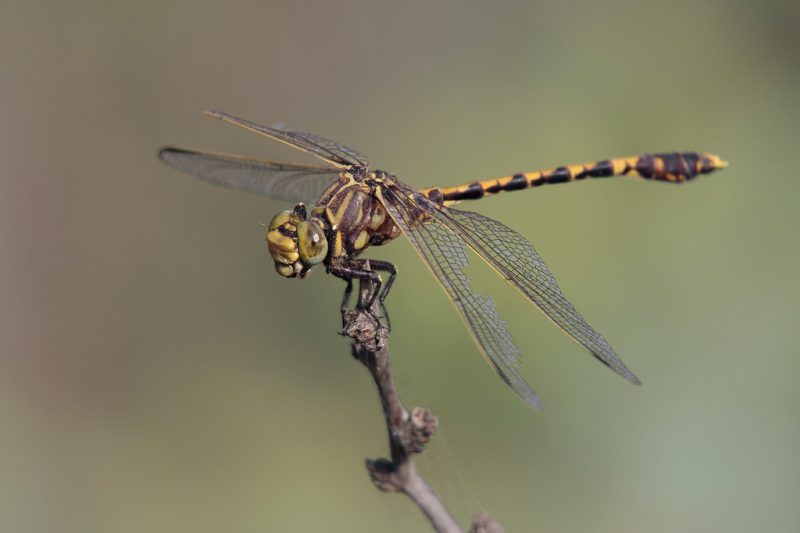
The Common Sanddragon is a medium-sized dragonfly, measuring approximately 1.5 to 2 inches long with a wingspan of about 2.5 inches. Its body is sandy brown with subtle yellow markings, and the wings are clear with slight amber tinges at the base. The coloration provides excellent camouflage against sandy or muddy riverbanks.
These dragonflies are fast and agile fliers, hunting for small insects close to the ground or water surface. Males are territorial, often defending burrowing sites where females lay eggs. Sanddragons are known for quick, erratic flights and brief perching on low vegetation or exposed sand.
In Ohio, Common Sanddragons are typically found near sandy or muddy edges of rivers, streams, and lakes with clean, well-drained soils. They prefer open areas with direct sunlight, which enhances their hunting efficiency. Adults are most active during the summer months when insect prey is abundant.
Lancet Clubtail (Gomphus exilis)
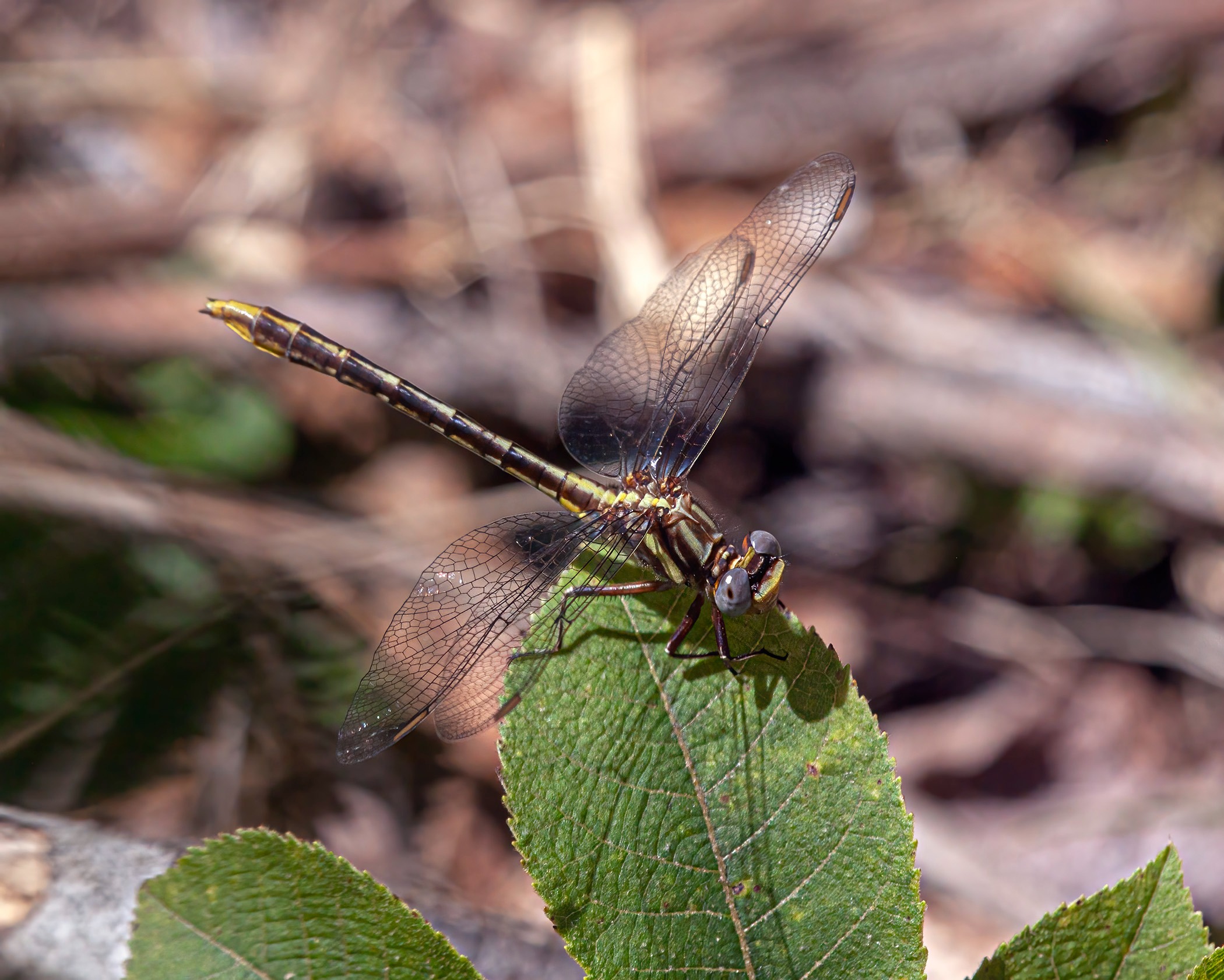
The Lancet Clubtail is a medium-sized dragonfly, measuring about 2 to 2.5 inches in length with a wingspan of roughly 3 inches. Its slender abdomen is primarily black with yellow stripes along the sides, and the club-shaped tip of the abdomen is slightly widened in males. The thorax is dark with pale lateral stripes, and the eyes are widely separated, a characteristic feature of clubtails.
These dragonflies are strong fliers, often patrolling streams, rivers, and ponds in search of small insects. Males are territorial and actively defend stretches of water against rivals. Lancet Clubtails are frequently observed perching on rocks, logs, or vegetation near the water, launching short hunting flights to catch prey.
In Ohio, Lancet Clubtails prefer clean, shallow rivers and streams with sandy or gravelly bottoms. They thrive in areas with moderate water flow and partial sunlight, often using open banks for perching and mating. Their presence is a good indicator of healthy freshwater habitats.
Arrowhead Spiketail (Cordulegaster obliqua)
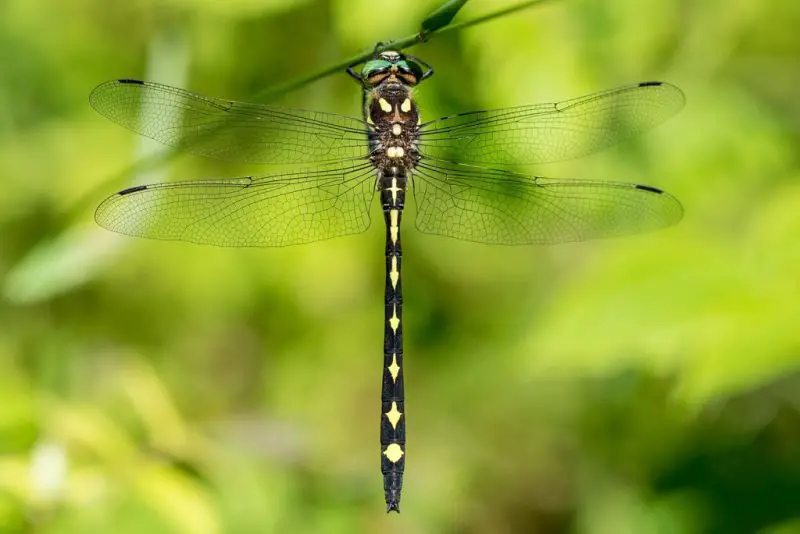
The Arrowhead Spiketail is a large dragonfly, typically 2.5 to 3 inches in length with a wingspan around 3.5 inches. Its body is predominantly black with bright yellow lateral stripes, giving it a striking, patterned appearance. The eyes are large and widely separated, and the wings are clear, enabling swift and agile flight.
These dragonflies are powerful fliers, patrolling streams and rivers where they hunt smaller insects. Males are highly territorial, defending prime breeding sites and performing aerial displays to deter competitors. They are often seen perched on vegetation or rocks along water edges, ready to dart out for prey.
In Ohio, Arrowhead Spiketails inhabit clean, flowing streams with sandy or gravelly substrates. They favor areas with open sunlight and minimal tree cover over the water, which allows them to patrol and hunt efficiently. Their presence often indicates excellent water quality.
Horned Clubtail (Arigomphus cornutus)
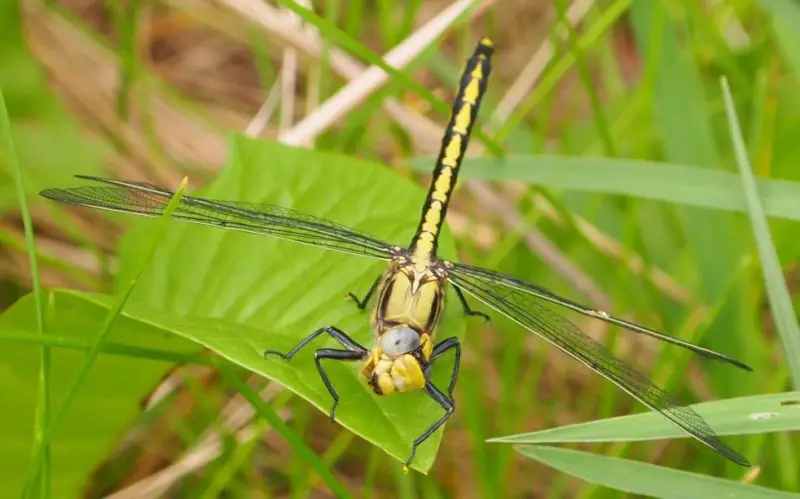
The Horned Clubtail is a medium-sized dragonfly, measuring approximately 2 to 2.5 inches long with a wingspan near 3 inches. Its body is dark brown with yellow lateral markings, and males feature small horn-like projections on the top of the thorax. The abdomen ends in a slightly widened “club,” giving the species its name.
Horned Clubtails are agile fliers that patrol ponds, lakes, and slow streams. Males are territorial and often perch on low vegetation or sandy banks to monitor their territory. They hunt insects such as mosquitoes and flies with swift aerial attacks, frequently returning to the same perching spots.
In Ohio, Horned Clubtails are commonly found in calm freshwater habitats with sandy or muddy bottoms. They prefer sunny areas with sparse vegetation along the water’s edge, which provides optimal perches for hunting and mating. Sightings are most common in mid to late summer.
Blue Corporal (Ladona deplanata)
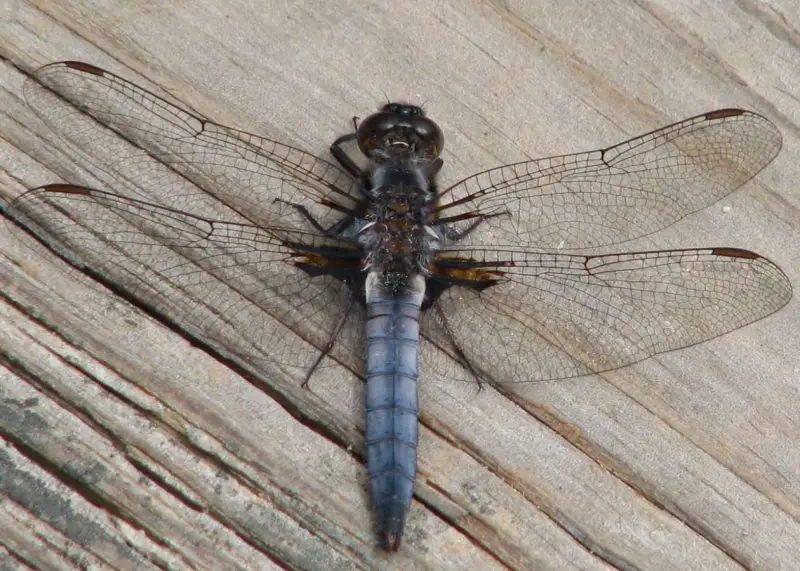
The Blue Corporal is a small dragonfly, measuring about 1.5 inches in length with a wingspan of 2 to 2.5 inches. Males have bright powder-blue abdomens and dark brown thoraxes with light stripes, while females are more muted, with brownish bodies and subtle markings. The wings are clear, making the vibrant male coloration stand out prominently in flight.
These dragonflies are active hunters, often darting close to the surface of ponds and slow streams to catch small flying insects. Males are territorial, frequently defending perches along water edges. They are often observed resting on stones, logs, or low vegetation between hunting flights.
In Ohio, Blue Corporals are found near ponds, marshes, and slow-moving streams with sunny, open conditions. They prefer habitats with ample emergent vegetation for perching and hunting. Observations are most frequent during early to mid-summer, when adult activity peaks.
Spot-winged Glider (Pantala hymenaea)
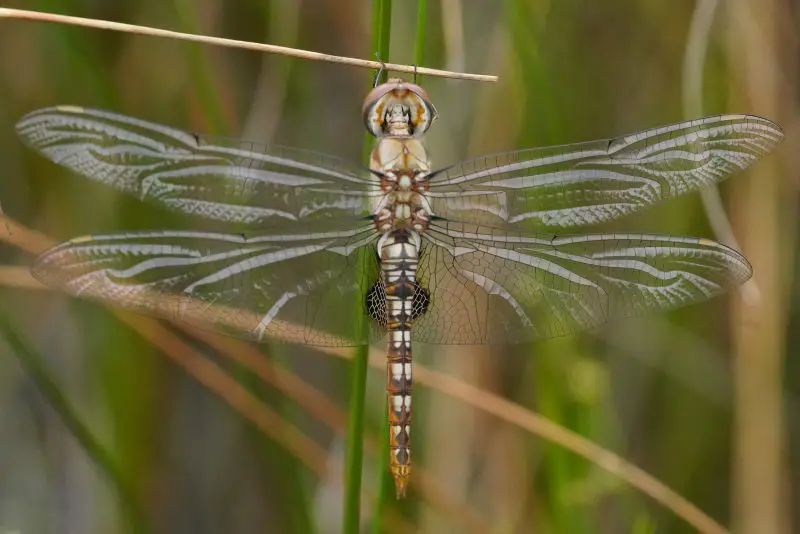
The Spot-winged Glider is a medium-sized dragonfly, measuring 1.75 to 2 inches in length with a wingspan around 3 inches. Its body is golden-yellow to brown, and the wings are mostly clear with small, dark spots near the tips. This species is highly migratory, with slender wings and a streamlined body built for long-distance flight.
These dragonflies are strong, continuous fliers, often seen patrolling over ponds, fields, and open water surfaces. They feed on mosquitoes, flies, and other small insects, catching them in rapid aerial pursuits. Spot-winged Gliders are less territorial than many species, often seen in loose swarms during migration periods.
In Ohio, Spot-winged Gliders are most commonly observed near open water bodies, wet meadows, and agricultural fields. Their migratory nature means they may appear in large numbers during warm, late summer months. They are adaptable and can thrive in a variety of sunny, open habitats with abundant prey.
Eastern Forktail (Ischnura verticalis)
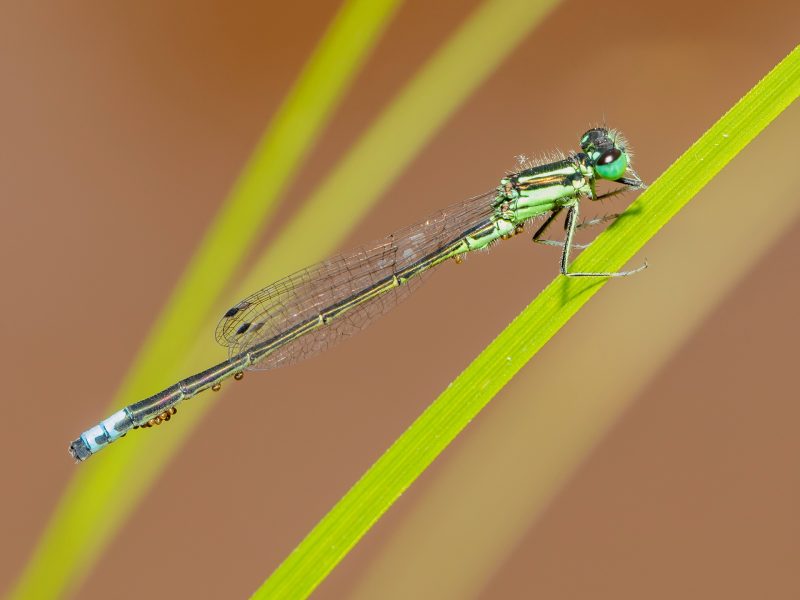
The Eastern Forktail is a small damselfly, typically measuring about 1 to 1.25 inches in length with a wingspan of roughly 1.5 inches. Males have a bright blue thorax with black dorsal stripes and a mostly black abdomen accented with blue segments near the tip. Females are more subdued, often greenish or brown with pale markings. Their slender bodies and clear wings make them agile and delicate fliers.
Eastern Forktails are active hunters, feeding on tiny insects such as midges and gnats. Males are territorial and often patrol small stretches of ponds, lakes, and marshes. They are frequently seen perching on emergent vegetation or low plants near the water, launching brief flights to capture prey.
In Ohio, Eastern Forktails inhabit ponds, slow streams, and wetlands with abundant aquatic vegetation. They prefer sunny areas where water surfaces are calm, which allows them to hunt efficiently. Observations are most common from late spring through summer, when adults are fully active.
Tule Bluet (Enallagma carunculatum)
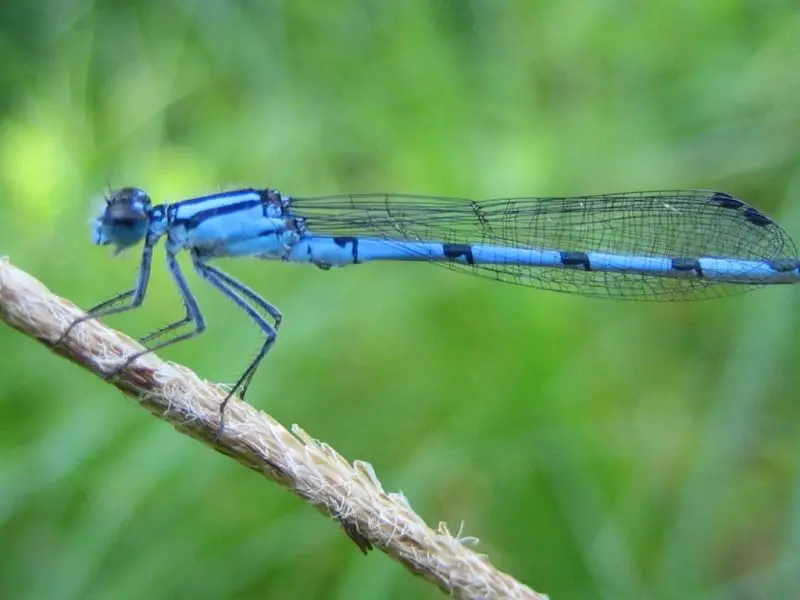
The Tule Bluet is a small damselfly, usually measuring 1 to 1.25 inches in length with a wingspan around 1.5 inches. Males are bright blue with black dorsal stripes and a thin, segmented abdomen, while females are pale greenish to brown with subtle black markings. Their delicate, slender bodies and clear wings make them excellent fliers over calm water surfaces.
These damselflies are active hunters, capturing tiny flying insects near ponds, marshes, and slow streams. Males patrol territories, often hovering low over water or perching on reeds. They are highly agile, darting back and forth to catch prey with precision.
In Ohio, Tule Bluets are commonly found in marshy wetlands, ponds, and small lakes, particularly in areas with emergent vegetation such as cattails and sedges. They are most often observed in early to mid-summer and are a common species in Ohio’s freshwater habitats.
Familiar Bluet (Enallagma civile)

The Familiar Bluet is a small damselfly, measuring about 1 to 1.25 inches long with a wingspan near 1.5 inches. Males have a vibrant blue thorax with black dorsal markings and a slender, blue and black segmented abdomen. Females are typically brownish or greenish with pale markings, and their slender form allows them to blend into reeds and grasses near water.
These damselflies are active hunters of small insects, patrolling calm ponds, lakes, and marshes. Males often establish territories near the water’s edge, perching on low plants or reeds between flights. They are agile fliers, capable of hovering and darting with precision.
In Ohio, Familiar Bluets are abundant near ponds, small lakes, and slow streams with emergent vegetation. They thrive in sunny areas where water is calm and insect prey is plentiful. Observations peak during late spring and summer, when adults are actively feeding and mating.
Northern Bluet (Enallagma annexum)
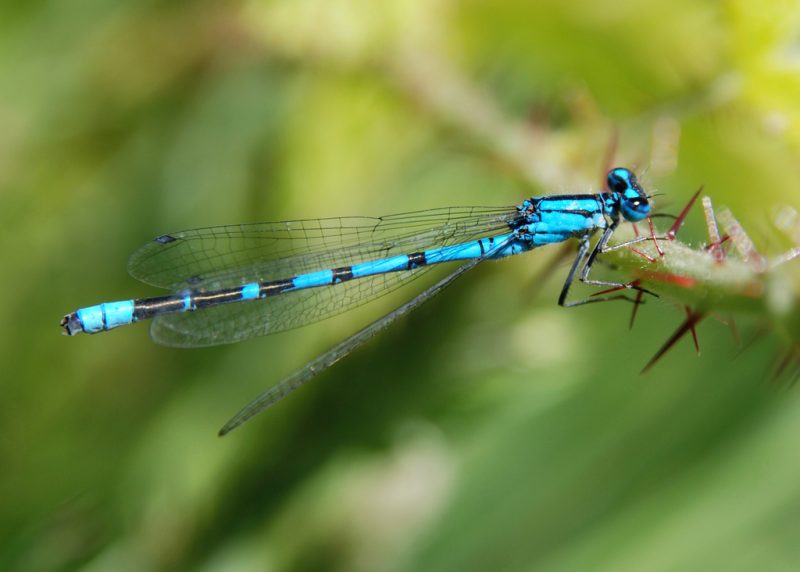
The Northern Bluet is a small damselfly, generally measuring 1 to 1.25 inches in length with a wingspan around 1.5 inches. Males are bright blue with black dorsal stripes, while females are more muted, ranging from greenish to brown. Both sexes have a slender, delicate body and clear wings that allow for nimble flight near the water surface.
Northern Bluets are active hunters, feeding on small flying insects such as gnats and midges. Males patrol territories around ponds and wetlands, frequently hovering above vegetation to monitor intruders. These damselflies are agile flyers, often performing short, precise flights to capture prey.
In Ohio, Northern Bluets inhabit ponds, marshes, and slow streams, especially in areas with abundant emergent vegetation. They prefer sunny, calm waters that allow them to hunt efficiently. Adults are most commonly observed from late spring through summer.
Azure Bluet (Enallagma aspersum)
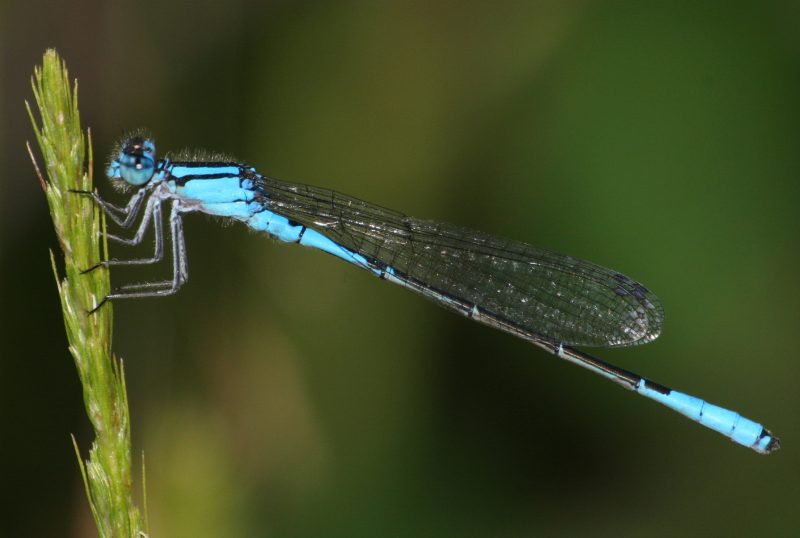
The Azure Bluet is a small damselfly, typically 1 to 1.25 inches in length with a wingspan of about 1.5 inches. Males display bright blue and black coloration along the thorax and abdomen, while females are generally brownish or greenish with subtle markings. Their slender, delicate bodies make them graceful fliers over ponds and wetlands.
These damselflies are active predators, feeding on tiny insects hovering near the water surface. Males patrol territories, often perching on reeds or low plants between flights. They are agile and fast, able to dart and hover with precision to catch prey.
In Ohio, Azure Bluets are commonly found around ponds, lakes, and marshes with ample emergent vegetation. They prefer sunny habitats where water is calm, and adult activity peaks during late spring and summer. Their bright blue coloration makes males particularly noticeable in Ohio’s damselfly populations.
Belted Whiteface (Leucorrhinia proxima)

The Belted Whiteface is a small dragonfly, typically measuring about 1 to 1.25 inches in length with a wingspan of roughly 1.5 to 2 inches. Its body is primarily dark brown to black, with a distinctive pale white band across the thorax, giving it the “belted” appearance. The eyes are dark, and the wings are clear with minimal markings, highlighting the contrasting body colors.
These dragonflies are active hunters, capturing tiny insects such as midges and mosquitoes near ponds and wetlands. Males are territorial, often patrolling small perches and chasing intruders away. They are frequently observed hovering close to vegetation or water surfaces while hunting.
In Ohio, Belted Whitefaces inhabit small ponds, marshes, and slow-moving streams with abundant emergent vegetation. They prefer sunny locations where water is calm, allowing them to hunt efficiently. Their presence is a common and noticeable sight during late spring and summer.
Eastern Whiteface (Leucorrhinia intacta)
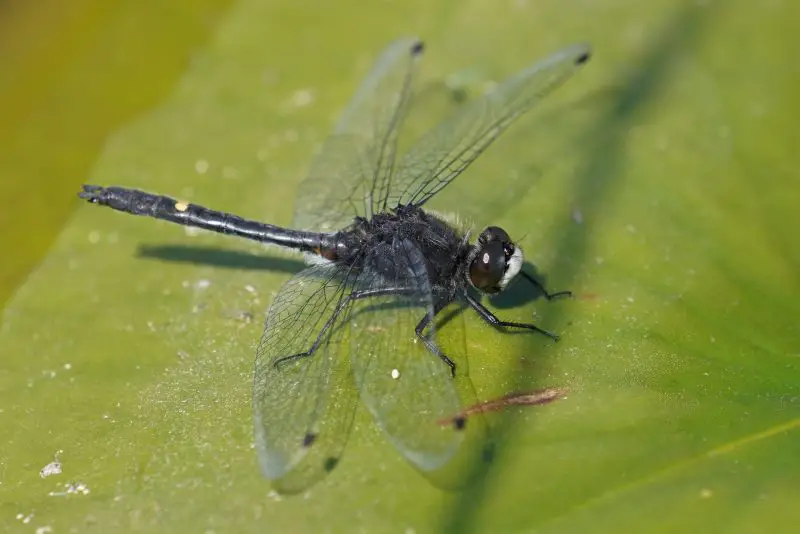
The Eastern Whiteface is a small dragonfly, measuring about 1 to 1.25 inches in length with a wingspan near 1.5 to 2 inches. It has a dark brown to black body, with a characteristic white face and pale thoracic markings. The clear wings enhance the visibility of the white facial and thoracic contrasts. Females tend to be slightly lighter in color than males.
Eastern Whitefaces are agile hunters, often patrolling ponds, marshes, and wetlands for small flying insects. Males establish and defend territories near water edges, frequently performing short flights to capture prey or ward off rivals. They are often observed perching on low vegetation.
In Ohio, Eastern Whitefaces are found in sunny, calm freshwater habitats such as ponds and marshes. They favor areas with abundant emergent vegetation for perching and hunting. Adult activity peaks in late spring and summer when prey is plentiful.
Spotted Whiteface (Leucorrhinia intacta variant)
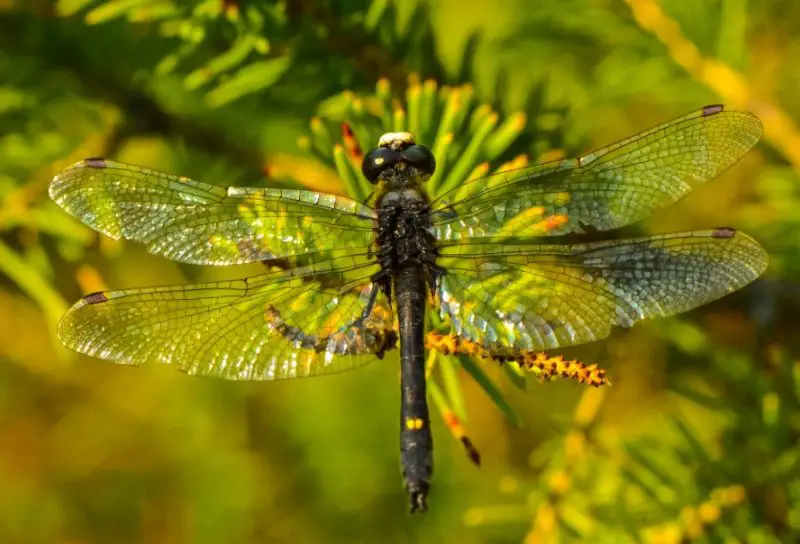
The Spotted Whiteface is a small dragonfly, similar in size to the Eastern Whiteface, about 1 to 1.25 inches long with a wingspan around 1.5 to 2 inches. Its dark brown to black body features small pale spots along the abdomen and a characteristic white face. The clear wings allow the spotting pattern to stand out, especially in sunlight.
These dragonflies are active predators, hunting tiny insects near ponds, marshes, and slow streams. Males are territorial, defending perching spots and prime hunting zones from rivals. They are often seen hovering low over water or resting on emergent vegetation between flights.
In Ohio, Spotted Whitefaces inhabit ponds, marshes, and wetlands with sunny, open conditions. They prefer areas with abundant reeds and grasses, which provide excellent perching sites. Observations are most common in late spring and summer.
Cherry-faced Meadowhawk (Sympetrum internum)
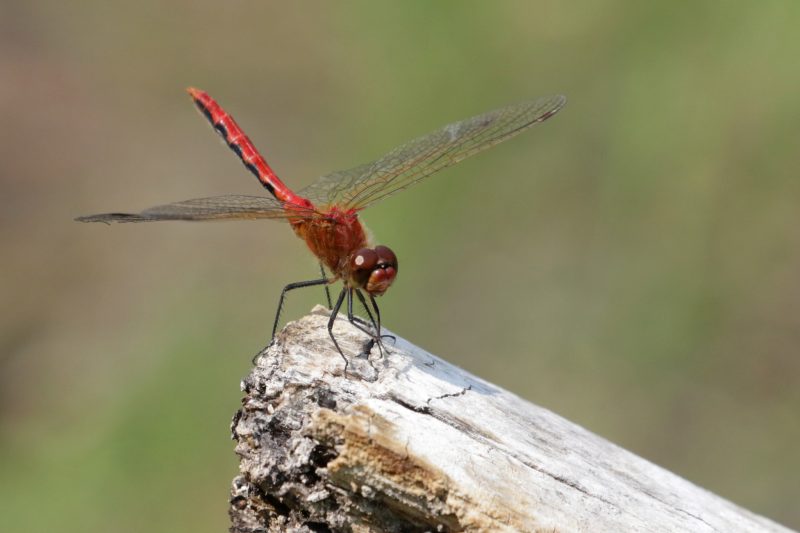
The Cherry-faced Meadowhawk is a small to medium dragonfly, measuring about 1.25 to 1.5 inches in length with a wingspan near 2 inches. Males are bright red with darker thoracic stripes and a reddish face, while females are yellowish to orange with similar markings. The wings are clear, highlighting the vivid body coloration.
These dragonflies are agile hunters, often patrolling ponds, marshes, and wet meadows for small flying insects. Males are territorial, frequently performing short flights to defend perches and attract females. They are commonly observed resting on low vegetation between hunting bouts.
In Ohio, Cherry-faced Meadowhawks inhabit sunny ponds, wetlands, and open fields near water. They are most active in late summer and early fall, often forming small groups during feeding and breeding periods. Their bright red coloration makes males particularly noticeable in Ohio habitats.
Ruby Meadowhawk (Sympetrum rubicundulum)
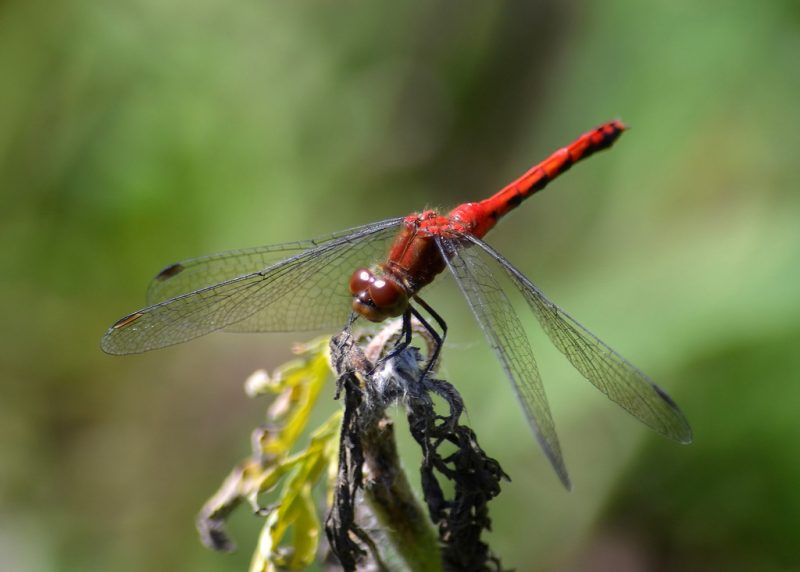
The Ruby Meadowhawk is a small to medium dragonfly, usually 1.25 to 1.5 inches long with a wingspan of about 2 inches. Males are bright red with subtle black markings along the thorax and abdomen, while females are yellow-orange with darker accents. The wings are clear, allowing the vivid body coloration to be easily seen during flight.
Ruby Meadowhawks are active predators, hunting small flying insects near ponds, lakes, and marshes. Males establish territories and perform short aerial displays to attract females and repel competitors. They often perch on low vegetation, launching quick flights to intercept prey.
In Ohio, Ruby Meadowhawks are found in sunny, calm wetlands, ponds, and slow streams with abundant emergent plants. They are most commonly observed from late summer through early fall, and their striking red coloration makes males easily recognizable in Ohio’s dragonfly populations.
FAQs About Ohio Dragonflies and Damselflies
What are the most common dragonflies in Ohio?
Ohio is home to a wide variety of dragonflies, including the Common Green Darner, Blue Dasher, Eastern Pondhawk, Widow Skimmer, and Halloween Pennant. These species are often seen near ponds, lakes, and marshes throughout the state, especially during the summer months.
How can I identify different dragonfly species in Ohio?
Dragonflies can be identified by their size, body color, wing patterns, and behavior. For example, the Common Green Darner has a bright green thorax and blue abdomen, while the Widow Skimmer has distinctive black and white wing bands. Observing perching habits and flight patterns also helps in identification.
Where do Ohio dragonflies typically live?
Dragonflies inhabit freshwater environments such as ponds, lakes, rivers, marshes, and slow-moving streams. Many species prefer areas with abundant emergent vegetation, which provides perching spots, hunting grounds, and breeding sites.
When is the best time to see dragonflies in Ohio?
The peak activity period for dragonflies in Ohio is from late spring through summer and into early fall. Species like the Autumn Meadowhawk and Ruby Meadowhawk are more common in late summer and early fall, while early-season species like the Chalk-fronted Corporal appear in late spring.
What do Ohio dragonflies eat?
Dragonflies are carnivorous and feed primarily on small flying insects, including mosquitoes, flies, gnats, and even smaller dragonflies. They are agile hunters, capturing prey mid-flight with exceptional speed and precision.
Are Ohio dragonflies migratory?
Some Ohio species, such as the Common Green Darner and Spot-winged Glider, are migratory. They travel long distances between states during summer and fall. Most other species remain local, patrolling and defending territories near their freshwater habitats.
How can I attract dragonflies to my pond or garden?
Providing a clean, calm water source with plenty of emergent vegetation such as reeds and cattails helps attract dragonflies. Avoiding pesticides and maintaining sunny areas around the water also encourages dragonflies to hunt and breed in your garden or pond.
Are dragonflies beneficial for the environment?
Yes, dragonflies play a critical role in controlling insect populations, particularly mosquitoes and other small flying insects. Their presence indicates a healthy aquatic ecosystem, and they serve as food for birds, fish, and other wildlife.
How do damselflies differ from dragonflies?
Damselflies are generally smaller and more delicate than dragonflies. Their wings are usually held together above the body when at rest, while dragonflies hold their wings open. Damselflies also tend to have slimmer abdomens and more subdued colors compared to many dragonfly species.
Can I safely handle dragonflies?
Dragonflies are harmless to humans and do not bite or sting. However, they are delicate insects, so handling them can cause injury. Observing them without touching is the safest way to enjoy these fascinating creatures.

